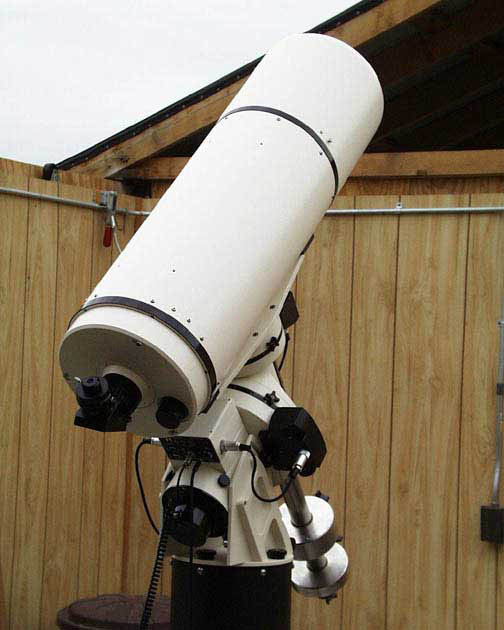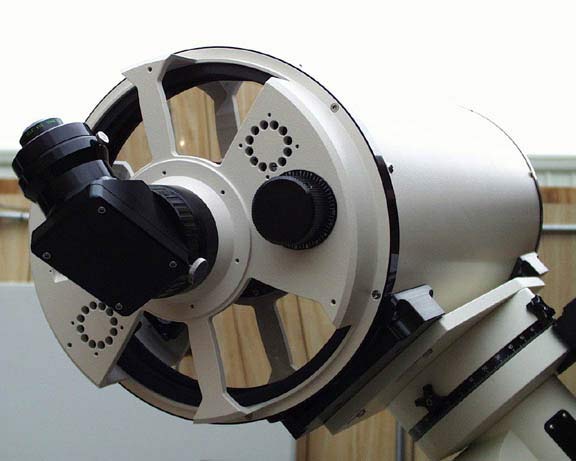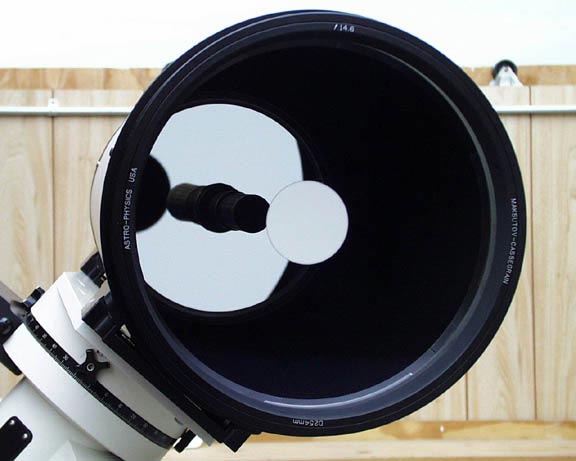ASTRO-PHYSICS HISTORY
10" F14.6 High-Resolution
Maksutov-Cassegrain
The
10" f14.6 Maksutov-Cassegrain is not available to purchase and
we do not have any plans to produce additional scopes
with these exact specifications. This information is presented
for present owners and
those who are curious about its history.
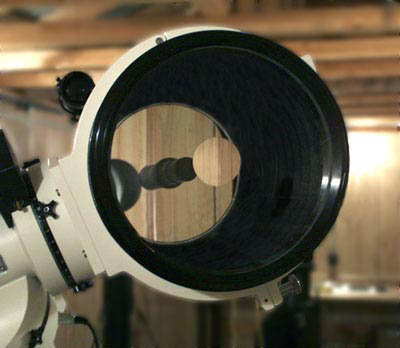
10" Mak under test in our roll-off roof observatory.
Note the small secondary obstruction. |
This telescope was developed for those desiring a no-compromise high-power instrument for all visual and imaging needs. Ideal for lunar/planetary, double star and high-resolution deep-sky observing.
Advanced Optical Design
The heart of this Maksutov is a special variation of the Gregory design using an elliptical primary and low-power corrector to achieve the lowest possible central obstruction, yet still maintain a reasonable focal ratio. The optics were designed by Valery Deryuzhin of Aries Instrument Company in the Ukraine. The design is coma-free and totally diffraction-limited from deep infrared right into the ultraviolet - a perfect match for today’s premium CCD chips. The small obstruction results in a telescope that shrugs off poor seeing as if it were a refractor, delivering high-contrast performance with super-tight star images.
Thermally Stable
From years of experimenting with 8" and 10" prototypes, we have found very effective ways to rapidly cool down the optics for stable high-power viewing. We have been testing this 10" design for several years in all kinds of weather from warm summer nights to bitter cold winter conditions with rapidly falling temperatures. With its fused silica primary, the figure is remarkably stable even when the optics are still cooling down to the ambient temperature. To minimize thermal gradients and help the mirror shed its heat, we designed a special mirror cell assembly. Cool night air can flow across the back of the mirror. To further speed up the cooling process in the most extreme conditions, we have added two small fans, which can be run at full speed, or at a slow whisper quiet speed. The air blows directly at the back of the mirror - no air goes inside the tube and cannot cause particulate contamination of the mirror surfaces.
The mirror is a truncated cone to eliminate as much thermal mass as possible. The back of the mirror is fine ground and polished, which helps internal trapped heat to radiate out the open back. By grinding the edge and back, tiny stresses are relieved which could otherwise introduce unwanted distortions in the highly accurate front surface at different ambient temperatures. In side-by-side tests against closed back scopes with conventional molded mirrors, our design was faster, by far, in achieving a stable, accurate image.
Central Obstruction
This 10" Mak-Cas design has a 23% central obstruction for highest possible planetary contrast at high powers. This obstruction also acts as a baffle to keep stray light from the sky from falling directly on the eyepiece. For high-power eyepieces, a 23% obstruction is enough to fully shield the field of view from this stray light. When the field of view exceeds about 1 inch diameter, light from the sky can leak past the front baffle and reduce the contrast at the edge of the field. Therefore, for low-power, widefield viewing with 2" eyepieces, we provide a larger secondary baffle that will increase the front baffle size to 32% to block this stray light in the outer portions of the field. This is needed primarily when sky light-polution is high and you are using low-power widefield eyepieces to observe faint deep-sky objects. Under dark skies, there will be no difference in contrast. Note: this secondary baffle threads onto the front of the corrector. The photos shown below do not show the method of attachment on the corrector.
Much has been written pro and con about the need for a small central obstruction. While the light loss of a secondary obstruction is quite small, even in a large obstruction, undesirable diffraction effects are in direct proportion to the obstruction size. Our observations over more than 20 years with all kinds of optical systems have convinced us of the desirability of small obstructions for visual systems. Commercial "fast food" catadioptrics have obstructions between 35% to 40% (and this includes some Mak-Cass designs also).
| This level of obstruction produces a noticeable reduction in the amount of light concentrated in the central Airy disc and a subsequent increase in the brightness of the first, second and higher diffraction rings, even when the optics are perfectly figured. When the atmosphere becomes unsteady, more and more energy is thrown out from the central Airy disc into the diffraction rings. As the seeing degrades, at some point the Airy disc merges with the first and subsequent diffraction rings to form an indistinct fuzzy blob. This degradation of the image happens much more frequently in a larger obstructed system where the diffraction rings already contain a large percentage of the incoming energy.
Any optical imperfections, such as surface roughness and zonal errors on the mirrors, adds to the problem. We tested a commercial scope where the central obstruction, optical errors and surface roughness were large enough to cause the first diffraction ring and central Airy disc to have almost equal brightness (with a 35% obstruction, theoretically there should be at least a 4 to 1 difference). |

High power image of Vega taken with 10" Mak using an Olympus DL600 digital camera. Seeing was 7 out of 10. Shown is Airy disc and first diffraction ring. |
Even so, this scope "tested" very well on the star test - it had quite similar inside and outside Fresnel patterns and might be judged textbook perfect by the star test. Yet it was a very poor performer on all but the most steady of nights, when the seeing was essentially perfect. The slightest motion in the atmosphere would cause cotton ball stars. This is one reason I have not been a major fan of the "star test" to evaluate the actual performance of a telescope. The only unbiased way to measure an optic is with interferometry, with an MTF (modulation transfer function) test, or with a PSF (point spread function) test, which measures the relative strength of the Airy disc vs. the diffraction rings with the image IN FOCUS.
Optical Quality
All of our 10" Mak optics are hand-finished and figured at Astro-Physics until
they meet or exceed a wavefront error of 1/10 wave P-V using a green light
interferometer in double-pass mode. We use precision-annealed blanks of Corning
fused silica for the mirrors, and solid blanks of high-quality Ohara BK7 for
the correctors. That way, there is no question of internal homogeneity, striae
or strain. They are expensive, but they free the optician to concentrate on
making very accurate and smooth curves on the optical surfaces without having
to compensate for local discontinuities in the glass, or worrying about the
mirror warping during polishing. Fused silica was chosen both for its high
stability during polishing and figuring, and for its thermal performance under
actual night-sky conditions. The end result is an optical system that does
what it’s supposed to do - produce unparalleled views of the planets and deep-sky
objects.
Coatings
To insure the highest possible light throughput, we have chosen an expensive multi-coating process for the corrector and mirror surfaces. The corrector anti-reflection coatings are so efficient that the corrector glass almost disappears and the secondary spot seems to float in the air. You can see this effect in the photo at the top of the page. The result is high light-gathering power and exceptional contrast, superior for faint deep-sky viewing and imaging.
Mechanical Design and Execution
Our tube assemblies were designed right from the start with trouble-free precision as the major goal. This means that collimation is set at the factory and does not change for the life of the instrument. To achieve this, all optics are accurately centered, including the mirror backs. All mounting components are made from solid billet aluminum - no fragile die castings anywhere! The critical mirror cell starts out as a solid 12" diameter aluminum slug weighing in excess of 30 lb. It is then precisely machined to very tight tolerances on our Mori-Seiki SL300 turning center. The finished mirror cell with its ventilation cutouts weighs a mere 2 lb. The other 28 lb. in the form of chips is, of course, recycled. Similar care is taken with the corrector cell and other mounting components. The result is a scope you can count on to produce consistently excellent images any time, any place.
|
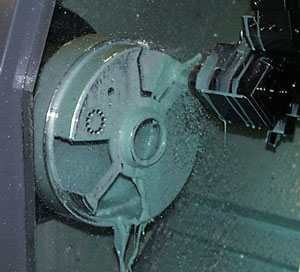
Mirror cell being machined on the
Mori Seiki turning center |
Focuser Design
We opted for a moving mirror focuser to accommodate a wide variety of photographic and visual accessories. The goal was to achieve precise movement of the mirror down to the micron level with no image shift. To accomplish this, we designed a pre-loaded axial ball bearing assembly with a precision screw thread, which moves the mirror on its centerline, not off-axis as is done in the majority of commercial catadioptrics. With this system, your image will stay on that tiny CCD chip regardless of focuser position. You won’t have to install an aftermarket Crayford focuser for your critical applications. Best of all, the mirror maintains its collimation and won’t flop around as you go from one part of the sky to the other. No need to tie the mirror down with external bolts to keep it from shifting during a time exposure.
|
Major Features
- 10" Maksutov Cassegrain optical system with elliptical primary and spherical corrector
- Secondary is aluminized on back of corrector - stays in perfect collimation forever
- Coma-free design with sharp 2" field
- Precision moving mirror focuser with no image shift
- Highest quality optical materials for stable views in all temperature conditions
- Hand-figured optics by master opticians
- Quality cell components for long term stability of collimation
- Fast cool-down design beats all competitors, leaves commercial scopes in the dust
- Extremely small secondary obstruction for high-contrast images in not-so-perfect seeing
Specifications
| Clear aperture |
10 inches,
254mm |
| Secondary size |
2.3 inches,
23% |
| Focal length |
146 inches,
3708mm |
| Focus range |
9.5 inches,
241mm |
| Focal ratio |
f14.6 nominal,
f13.6 at min focus, f15.8 at max focus point |
| Field size |
3/4 degree
(1.5 moon diameters), over a 2 inch field |
| Magnification range |
62x with 60mm ocular
to 927x with 4mm ocular |
| Resolution |
0.45 arc seconds |
| Size |
12" diameter x 31.25" long,
incl the focuser |
| Weight of tube w/o dewcap |
33 lb.,
15kg. |
| Diameter of corrector cell
(to fit solar filter) |
290mm (11.4") |
| Finish |
Black anodized
cells, white textured tube |
| Mirror coating |
96% enhanced
and protected aluminum |
| Corrector coating |
Broadband multi-coatings
both sides |
Parts Included
These parts are included: Carrying Case, Dewcap, Secondary Baffle.
10" Mak-Cass on 1200 Mount
CCD Images taken with the 10" Mak-Cass
Check out the lunar, planetary, deep-sky
and double star images taken with this instrument from our less-than-ideal
suburban observing site at Astro-Physics.
Support
We have prepared some pertinent support documents relating to this scope and many of our other products on our Technical Support page. Please check there first to find the information that you need.
Upgrades and Spare Parts
Check out our Astro-Physics.com website to find accessories, replacement parts or learn about possible upgrades for your scope.
Copyright © 2004-2019 Astro-Physics Inc.
All rights reserved.
Last modified:
March 11, 2019
Astro-Physics,
Inc.
11250 Forest Hills Road, Rockford, IL 61115, U.S.A.
Phone: 815-282-1513 Fax: 815-282-9847




